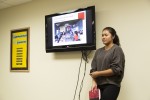One of Alana Sanchez-Prak’s larger host families during her trip to the Philippines relied on coconut trees as its primary source of income. The mother of the family remembered watching the roof fly off her home and seeing the trees collapse while trying to get her family to safety.
Typhoon Haiyan hit the Philippines eight months before Sanchez-Prak’s expedition through the country. Sanchez-Prak said she was surprised at how much rebuilding was still left to be done when she arrived.
Sanchez-Prak, a Samahang Pilipino member and second-year undeclared student, shared her story Monday night about her experience in aiding a community in the Philippines, where she went on a three-week mission trip this summer.
Samahang Pilipino funded the trip through donations from the Student of Color Conference and from money raised by selling T-shirts and bracelets, said Winnie Galbadores, a fourth-year sociology student and the external vice president of Samahang Pilipino.
Antonette Sadile, president of Samahang Pilipino and fourth-year Asian American studies student, said she hopes Samahang will be able to send at least one student a year to the Philippines in the future.
Sadile said she sees the lasting impact of sending Sanchez-Prak to her mother’s homeland and thinks that students who have questions about the devastation caused by the typhoon now have a person to talk to.
During her time in Davao, Talaingod and Quezon City this July, Sanchez-Prak helped distribute relief packets, donate tractors to revive agriculture and give out sturdy metal sheets to rebuild houses.
Typhoon Haiyan was one of the most destructive typhoons to hit the Philippines. It affected 16 million people and destroyed or damaged 1.1 million homes, according to the United States Agency for International Development. Students from all over the U.S. joined Filipino missionaries to help and rebuild the community through the Kapit Bisig Kabataan Network, a Filipino relief network.
Samahang also raised money to support typhoon relief efforts outside of sending Sanchez-Prak to the Philippines. Typhoon Haiyan Relief Committee, of which Samahang was a part, held a typhoon benefit concert which raised about $6,000. In spring, the Associated Students UCLA matched the amount of money raised.
Galbadores said she thinks global issues are important to UCLA students and that Filipino issues are relevant on campus.
Sanchez-Prak also said she got the opportunity to integrate with the Haiyan survivors and learn about psychosocial interventions. These psychosocial interventions were a way to analyze the mental health effects of the disaster on sixth- and seventh-grade school students, she said.
Drawing was a big part of these interventions. Sanchez-Prak said she remembers an activity where students were asked to divide a sheet of paper into four and draw “what makes them happy, sad, scared, etc.” Many of these students drew pictures of trees falling to depict what makes them scared.
She said she was surprised to see how affected the kids were by the typhoon.
“I learned that there is a lot more to making sure people are OK than just physical things,” Sanchez-Prak said.
Typhoon Haiyan traumatized the daughter of another host family she stayed with, Sanchez-Prak said. One night during Sanchez-Prak’s stay, a storm hit and the young girl began screaming and crying. Sanchez-Prak looked to the girl’s grandmother for an explanation, and the grandmother told her the girl was scared there was another typhoon coming.
Throughout her presentation, she focused on her connections to the locals in the towns she visited. Sanchez-Prak said she considers the community integration with Haiyan survivors the best two days of her trip.
“The purpose was to hear their stories,” Sanchez-Prak said.
After hearing and reading about the destruction, Sanchez-Prak said the mission made her understanding of the typhoon more tangible and she said it will help her teach others about the event.
